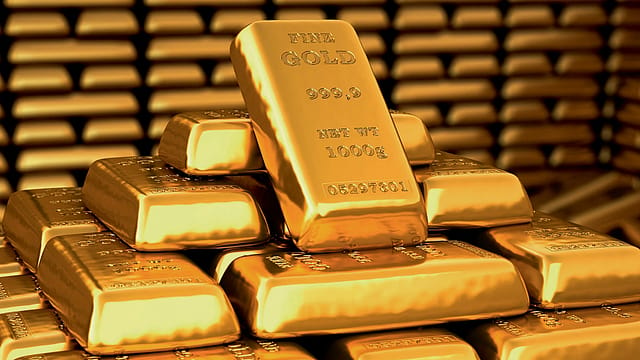Central Banks tank up gold reserves
ADVERTISEMENT

In the first six months of 2023, Central Banks across the world acquired an unprecedented 387 tonnes of gold, marking the highest H-1 purchase of gold volume since 2000, when the World Gold Council began recording such transactions. Central Banks do stock up gold in low economic cycles, yet the recent surge in gold purchases is striking given the concurrent interest rate hikes.
Historically, as interest rates climb, the appeal of non-interest-bearing assets like gold diminishes, prompting a decline in gold prices. But the conventional inverse relationship between rising interest rates and gold prices is being challenged on account of the strong demand of Gold from Central Banks.
The charm of Aurum was quite evident in CY22 too when Central Banks cumulatively bought 1,136 tonnes of gold. It was the second-largest gold buying after 1967, when Central banks had bought a net of 1,404 tonnes of Yellow Metal.
Yellow Metal being a part of Central Banks' reserve (War Chest), prices of Gold depend heavily on buying tendencies of these monetary organisations.
Interestingly, in last 18 months, Central Banks' gold buying spree gained in the backdrop of rising interest rates globally. Between March 2022 and May 2023, the Federal Reserve has increased its benchmark federal funds rate in 10 consecutive meetings by a total of five percentage points. This is the steepest spate of rate hike in last 40 years. Since May 2022, the Reserve Bank of India (RBI) has raised rates by an aggregate 250 basis points (bps) bringing costs to a level of January 2019.
December 2025
The annual Fortune 500 India list, the definitive compendium of corporate performance, is out. This year, the cumulative revenue of the Fortune 500 India companies has breached $2 trillion for the first time. Plus, find out which are the Best B-schools in India.
Why Central Banks are buying gold even as interest rates are moving up? This affinity towards Yellow Metal also begs a question - Are monetary authorities of various nations losing faith in the US Dollar, in particular, and Fiat Currencies, in general?
China leading the buying spree
As per World Gold Council, nine Central Banks were net purchasers during the first half of 2023. The People's Bank of China reported adding 103 tonne during H-1, extending its monthly buying streak to eight months. Its gold reserves totaled 2,113 tonnes (4% of total reserves) at the end of June 2023.
The Monetary Authority of Singapore was the second largest buyer during H-1, adding 73 tonne, followed by the National Bank of Poland, which bought 48 tonne. Six other Central Banks that were net buyers in H-1 are India's Reserve Bank of India (10 tonne), Czech Republic (8 tonne), Philippines (4 tonne), Iraq (2 tonne), Qatar (2 tonne), and the European Central Bank (2 tonne)- related to the transfer of Gold from Croatia as it joined the Euro Area.
What's behind China Gold rush?
In times of rising geo-political uncertainties, higher inflation, and rising interest rates Central Banks' affinity towards gold increased considerably and it got reflected in the buying pattern of these banks.
In 2020 and 2021, global central banks bought 273 tonne and 463 tonne of gold, respectively, but in 2022, central banks cumulatively bought 1,136 tonne or 400 tonne above the previous two years combined. Heavy gold buying commenced on the backdrop of Russia-Ukraine war that prompted many Central Banks to sell US Treasuries and diversify their Forex Reserves through gold.
China is the second largest buyer of US Debt and holds US Treasuries worth $859 billion. Moreover, China is also planning to tackle the dominance of US and its Western allies. In the de-dollarisation drive, China is leading the BRICS block that also includes Brazil, Russia, India and South Africa. BRICS bloc is tinkering with the idea of launching a new trading currency which will be backed by Gold. Thus, not only China but other BRICS members like Russia and India have also increased their Gold Reserves in recent times.
It is estimated that around 25% of Russia’s Central Bank reserves are in the form of Gold while it holds less than 5% of its reserves in US Dollar. Following Russia’s February 2022 invasion of Ukraine, the US and its Western allies took the audacious step of seizing Russian reserves held in US Dollars. Observing this, other nations are now inclined to diversify their foreign exchange reserves away from the US dollar.
In the last few years, RBI ranked amongst the top gold buying Central Banks, globally. Of the total gold purchased by Central Banks in 2020 and 2021, the RBI bought 15.26% and 16.63%, respectively. In both these years, RBI was the second largest gold buyer amongst Central Banks. In 2022, RBI bought 33 tonne of gold. It seems that heavy gold buying by BRICS nations is an effort to change the global financial terrain that has been dominated by the US Dollar since the end of WW-II.
